Urinary L-type fatty acid-binding protein can reflect renal tubulointerstitial injury
- PMID: 19264908
- PMCID: PMC2671353
- DOI: 10.2353/ajpath.2009.080511
Urinary L-type fatty acid-binding protein can reflect renal tubulointerstitial injury
Abstract
This study aimed to elucidate the role of L-type fatty acid-binding protein (L-FABP) in renal tubulointerstitial injury using a mouse adenine-induced renal injury model. C57BL/6 mice fed excess dietary adenine for 6 weeks showed a gradual increase in levels of blood urea nitrogen (BUN). They also showed severe tubulointerstitial pathological findings, such as fibrosis and macrophage infiltration without glomerular damage, which were attenuated by treatment with either allopurinol or Y-700, a new xanthine dehydroxygenase inhibitor. Because renal expression of L-FABP is defective in C57BL/6 mice, human L-FABP transgenic mice were fed an adenine-containing diet. Transgenic mice showed lower BUN levels and lower levels of pathological injury compared with wild-type mice. On the other hand, urinary levels and renal expression of L-FABP in the adenine group was significantly increased and attenuated by treatment with either allopurinol or Y-700. Urinary L-FABP was positively correlated with BUN levels and pathological damages in the tubulointerstitium. No increases in urinary protein, albumin, or N-acetyl-beta-D-glucosaminidase levels were found for 6 weeks in any group. In conclusion, we demonstrated that urinary L-FABP levels can be used to monitor both dynamics and drug responses in a mouse adenine-induced tubulointerstitial injury model.
Figures


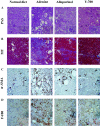
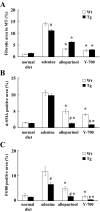
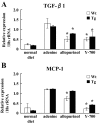
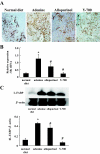
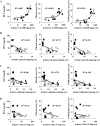
Similar articles
-
Urinary excretion of liver type fatty acid binding protein accurately reflects the degree of tubulointerstitial damage.Am J Pathol. 2009 Jun;174(6):2096-106. doi: 10.2353/ajpath.2009.080780. Epub 2009 May 12. Am J Pathol. 2009. PMID: 19435794 Free PMC article.
-
Renoprotective effect of the xanthine oxidoreductase inhibitor topiroxostat on adenine-induced renal injury.Am J Physiol Renal Physiol. 2016 Jun 1;310(11):F1366-76. doi: 10.1152/ajprenal.00517.2015. Epub 2016 Mar 30. Am J Physiol Renal Physiol. 2016. PMID: 27029427
-
Monitoring of urinary L-type fatty acid-binding protein predicts histological severity of acute kidney injury.Am J Pathol. 2009 Apr;174(4):1154-9. doi: 10.2353/ajpath.2009.080644. Epub 2009 Mar 5. Am J Pathol. 2009. PMID: 19264903 Free PMC article.
-
[L-type fatty acid binding protein (L-FABP) and kidney disease].Rinsho Byori. 2014 Feb;62(2):163-70. Rinsho Byori. 2014. PMID: 24800492 Review. Japanese.
-
[Urinary L-type fatty acid binding protein (L-FABP) as a new urinary biomarker promulgated by the Ministry of Health, Labour and Welfare in Japan].Rinsho Byori. 2013 Jul;61(7):635-40. Rinsho Byori. 2013. PMID: 24205707 Review. Japanese.
Cited by
-
Targeting Oxygen-Sensing Prolyl Hydroxylase for Metformin-Associated Lactic Acidosis Treatment.Mol Cell Biol. 2017 Jul 28;37(16):e00248-17. doi: 10.1128/MCB.00248-17. Print 2017 Aug 15. Mol Cell Biol. 2017. PMID: 28606929 Free PMC article.
-
Pharmacologic Blockade of αvβ1 Integrin Ameliorates Renal Failure and Fibrosis In Vivo.J Am Soc Nephrol. 2017 Jul;28(7):1998-2005. doi: 10.1681/ASN.2015050585. Epub 2017 Feb 20. J Am Soc Nephrol. 2017. PMID: 28220032 Free PMC article.
-
Contribution of xanthine oxidoreductase to mammary epithelial and breast cancer cell differentiation in part modulates inhibitor of differentiation-1.Mol Cancer Res. 2011 Sep;9(9):1242-54. doi: 10.1158/1541-7786.MCR-11-0176. Epub 2011 Jul 20. Mol Cancer Res. 2011. PMID: 21775420 Free PMC article.
-
Effects of dietary iron intake and chronic kidney disease on fibroblast growth factor 23 metabolism in wild-type and hepcidin knockout mice.Am J Physiol Renal Physiol. 2016 Dec 1;311(6):F1369-F1377. doi: 10.1152/ajprenal.00281.2016. Epub 2016 Oct 12. Am J Physiol Renal Physiol. 2016. PMID: 27733366 Free PMC article.
-
Oxalate-induced chronic kidney disease with its uremic and cardiovascular complications in C57BL/6 mice.Am J Physiol Renal Physiol. 2016 Apr 15;310(8):F785-F795. doi: 10.1152/ajprenal.00488.2015. Epub 2016 Jan 13. Am J Physiol Renal Physiol. 2016. PMID: 26764204 Free PMC article.
References
-
- Sarnak MJ, Levey AS, Schoolwerth AC, Coresh J, Culleton B, Hamm LL, McCullough PA, Kasiske BL, Kelepouris E, Klag MJ, Parfrey P, Pfeffer M, Raij L, Spinosa DJ, Wilson PW. Kidney disease as a risk factor for development of cardiovascular disease: a statement from the American Heart Association Councils on Kidney in Cardiovascular Disease, High Blood Pressure Research, Clinical Cardiology, and Epidemiology and Prevention. Circulation. 2003;108:2154–2169. - PubMed
-
- Risdon RA, Sloper JC, De Wardener HE. Relationship between renal function and histological changes found in renal-biopsy specimens from patients with persistent glomerular nephritis. Lancet. 1968;2:363–366. - PubMed
-
- Mackensen-Haen S, Bader R, Grund KE, Bohle A. Correlations between renal cortical interstitial fibrosis, atrophy of the proximal tubules and impairment of the glomerular filtration rate. Clin Nephrol. 1981;15:167–171. - PubMed
-
- Nath KA. Tubulointerstitial changes as a major determinant in the progression of renal damage. Am J Kidney Dis. 1992;20:1–17. - PubMed
Publication types
MeSH terms
Substances
Grants and funding
LinkOut - more resources
Full Text Sources
Medical
Molecular Biology Databases

